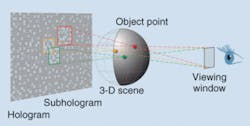HOLOGRAPHY: SeeReal develops practical real-time holographic display
A German company has developed a practical holographic-display technology that overcomes the historical challenges of insufficient display resolution, inadequate data volume, and daunting processing requirements. SeeReal Technologies (Dresden, Germany) demonstrated a prototype of the first practical real-time video holographic display using the new technology.1
The company says its initial 20 in. monochrome display is a first step toward the widespread adoption of three-dimensional (3-D) displays and projectors. This new technology could replace stereoscopic displays (and the associated eye fatigue that they can cause due to the mismatch between the convergence of the eyes and the focus of the eye lenses) within the next decade.
To generate a large-screen real-time holographic display, a classical approach to computer-generated holography (CGH) would require an extreme-resolution display with a pixel size of roughly 0.5 µm. Translated into a normal television size, this would require a resolution roughly 250,000 times that of today’s high-definition television (HDTV) capability of just over 6 million pixels. The highest available resolution today is only on the order of 30 million pixels. Moreover, real-time processing of this data would require a supercomputer to drive a single display.
Researchers at The Massachusetts Institute of Technology (MIT; Cambridge, MA) actually demonstrated the world’s first interactive electronic holographic image display using a high-resolution CGH process; however, only a few frames per second could be computed for a teacup-size display.2
To overcome these fundamental obstacles, SeeReal is using a new holographic technique called viewing-window technology and has demonstrated real-time hologram calculation on a commercial high-end graphics card at 30 frames per second for the 20 in. display.
The technology takes advantage of the fact that only the information aimed at the pupils of the viewer’s eyes is necessary to view the image scene (all other information is wasted). It is based on diffraction, in which the pixel pitch of the display determines the periodicity interval from which the 3-D scene coming from the display can be seen. This interval is called the viewing window (VW)—the hologram is encoded on the display and reconstructs the visible scene. That is, a VW at a reconstructed scene is created by interfering light waves emerging from the hologram and converging within the periodicity interval. The large reconstructed scene in the size of the hologram is perceived as a view through a virtual window—a window without glass. Reconstructed objects can have any position within the frustrum spanned by the VW and the hologram and beyond, up to infinity.
Viewing windows that move
A pixel pitch of 20 µm produces a periodicity interval of 20 mm at a distance of 80 cm. Although this small region is not sufficient to view a 3-D scene with both eyes, it can be used as a VW for one eye while the other eye is provided with its own VW using temporal multiplexing. This also applies to multiple viewers: if the VWs move according to the position of the viewer’s eyes, a viewer will not notice that all irrelevant information outside the VWs was eliminated (or did not exist), and a full holographic image can be seen.
Unlike a classic hologram, which requires calculation of millions to billions of complex values for each of the scene points (or pixels in a display), VW technology encodes each virtual point of the scene by a single dedicated subhologram. The subhologram only encodes the information actually visible at any time within the VW (only a few hundred or few thousand pixels). Thus, the subhologram technique reduces the computational load to “application-specific-integrated-circuit (ASIC)-capable” levels. Even more important, the subhologram technology alleviates the dynamic-range problem, increasing the image quality considerably and alleviating a severe problem with holography.
The SeeReal technology has the potential to eliminate the obstacles that have prevented the introduction of video holography at a consumer level by using liquid-crystal displays with today’s resolution as spatial-light modulators to produce holograms.
REFERENCES
1. A. Schwerdtner et al., SID 2007 Session 32, paper 32.3 (May 23, 2007).
2. M. Lucente, IBM Systems Journal35, 3 and 4, 349 (October 1996).
About the Author

Gail Overton
Senior Editor (2004-2020)
Gail has more than 30 years of engineering, marketing, product management, and editorial experience in the photonics and optical communications industry. Before joining the staff at Laser Focus World in 2004, she held many product management and product marketing roles in the fiber-optics industry, most notably at Hughes (El Segundo, CA), GTE Labs (Waltham, MA), Corning (Corning, NY), Photon Kinetics (Beaverton, OR), and Newport Corporation (Irvine, CA). During her marketing career, Gail published articles in WDM Solutions and Sensors magazine and traveled internationally to conduct product and sales training. Gail received her BS degree in physics, with an emphasis in optics, from San Diego State University in San Diego, CA in May 1986.
